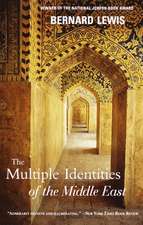An Aesthetic Occupation – The Immediacy of Architecture and the Palestine Conflict
Autor Daniel Bertrand Monken Limba Engleză Paperback – 17 mar 2002
Monk argues that those monuments that seem to repeatedly trigger outbursts of violence do not have the architectural immediacy attributed to them: they are not inherently political. Instead, political significance and content are endlessly projected onto them by those on both sides of the conflict. The legacy of General Charles George Gordon, a late-nineteenth-century British imperialist whose study of Palestinian holy sites, Monk argues, signalled the shift from focusing on the uses of the spaces to the claims for those uses. It is here, he claims, that sacred spaces became sites for rewriting the cultural politics of Modernity. Drawing on the unpublished archives of the family of Ernest Tatham Richmond, an architect and former Chief Secretary for Political Affairs to the British government in Palestine, Monk relates to the restoration of the Dome of the Rock to what he deems the chief historical crisis of architecture-that politics is presumed to use representations of holiness as fronts for its secular goals. The discourse following the violent Wailing Wall riots of 1929, when the opponents in Palestine were compelled to explain their own national imperatives through duelling interpretations of the cause of the conflict serves to demonstrate how the interpretations of others are reinterpreted, which constitutes the ultimate paradox of politics.
Preț: 264.26 lei
Nou
Puncte Express: 396
Preț estimativ în valută:
50.58€ • 54.96$ • 42.52£
50.58€ • 54.96$ • 42.52£
Carte tipărită la comandă
Livrare economică 21 aprilie-05 mai
Preluare comenzi: 021 569.72.76
Specificații
ISBN-13: 9780822328148
ISBN-10: 0822328143
Pagini: 272
Dimensiuni: 153 x 235 x 26 mm
Greutate: 0.45 kg
Ediția:New.
Editura: MD – Duke University Press
ISBN-10: 0822328143
Pagini: 272
Dimensiuni: 153 x 235 x 26 mm
Greutate: 0.45 kg
Ediția:New.
Editura: MD – Duke University Press
Cuprins
Abbreviations
Glossary
Note on Transliteration
Preface
Introduction: The Foundation Stone of Our National Existence, without Exaggeration
Part I. Stone
1. A Hieroglyph Designed by God
Part II. Tile
2. An Unmistakable Sign
3. You are Blind to the Meaning of the Dome of the Rock
4. Cataclysm and Pogrom: An Exergue on the Naming of Violence
Part III. Paper
5. Sir Alfred Mond’s After-Dinner Eloquence
6. Designs on Our Holy Places
Part IV. Celluloid
Conclusion: A Terrible Caricature
Notes
Bibliography
Index
Glossary
Note on Transliteration
Preface
Introduction: The Foundation Stone of Our National Existence, without Exaggeration
Part I. Stone
1. A Hieroglyph Designed by God
Part II. Tile
2. An Unmistakable Sign
3. You are Blind to the Meaning of the Dome of the Rock
4. Cataclysm and Pogrom: An Exergue on the Naming of Violence
Part III. Paper
5. Sir Alfred Mond’s After-Dinner Eloquence
6. Designs on Our Holy Places
Part IV. Celluloid
Conclusion: A Terrible Caricature
Notes
Bibliography
Index
Recenzii
"A revelatory history of the architectural construction of the Israel/Palestine conflict that is also a stunningly original contribution to critical theory in the tradition of Adorno and Benjamin. Monk shows how both sides - thanks in part to the British - became trapped in a deadly quicksand of sacralised geographies and imagined histories." - Mike Davis, author of City of Quartz
Notă biografică
Textul de pe ultima copertă
"Why is the question of Israel/Palestine so intractable? Why, in this supposedly enlightened, secular age, does there seem to be no exit from a conflict that has focussed obsessively on the material features of this tiny country for millennia? How is it that the very stones, monuments, and landscape have become so invested with conflicting values that they seem to have 'lives of their own' that are not simply shaped by historical events, but themselves play the role of causal agents in those events? Daniel Monk's brilliant and profound meditation on these questions eschews all the easy alternatives: it avoids the temptation both of one-sided polemics (on the one hand) and Olympian neutrality (on the other); it refuses to pass over the fetishizing of monuments and places as a mere symptom that could be dispelled by critique; above all, it insists on looking steadily at the objects themselves in all their paradoxical, conflicted formulations, their positioning in events, memories of events, and fantasies of a final event to come. This is an essential book for anyone who wants to think about the Holy Land, or about the way objects make and are made by history."--W. J. T. Mitchell, University of Chicago, Editor, "Critical Inquiry"
Descriere
The contested politics of space and architecture in Mandate Palestine.














